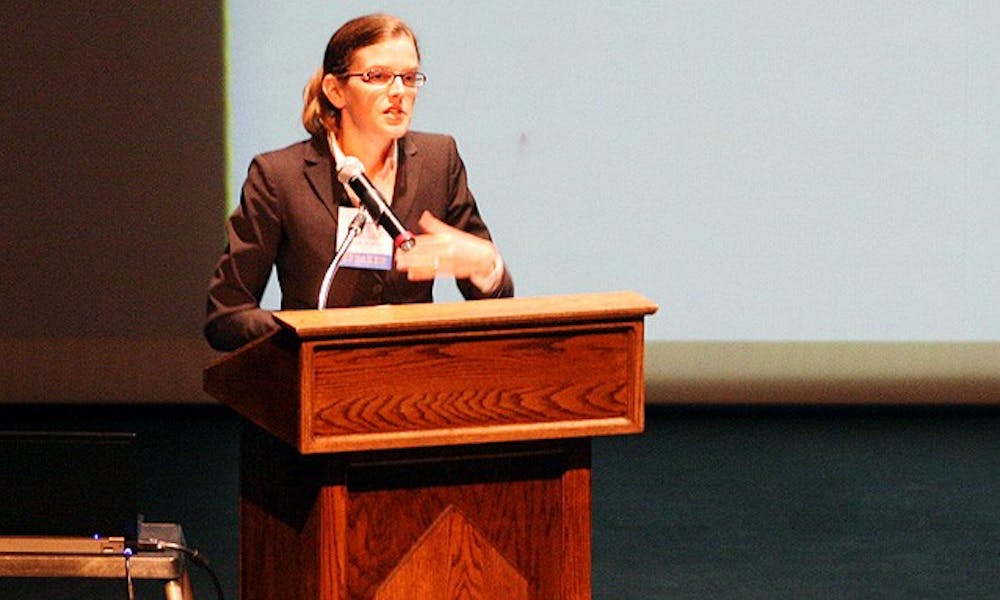Despite its contribution to economic growth, the controversial process of “fracking” poses serious environmental risks, nationally acclaimed experts said Monday.
Advocates and critics from environmental protection groups and research institutions gathered at the Reynolds Industries Theater for a workshop on the implications of fracking—a technique that extracts natural gas deposits by pumping water and chemicals deep into shale rock formations. The event was sponsored by the Nicholas School of the Environment and the Duke Environmental Law and Policy Forum at the School of Law, and it was funded by the National Science Foundation.
Hydraulic fracturing and shale gas development has garnered national attention because of the process’s association with methane and water contamination.
“Shale gas exploitation through fracking may save America from foreign oil, but it seems to cause methane contamination in the Appalachian basin,” said Avner Vengosh, professor of earth and ocean sciences at the Nicholas School. “Sustainable and long-term shale gas developments will need to accommodate the environmental issues associated with shale gas drilling and fracking.”
More than 15 million gallons of water per day are being used for fracking, Vengosh said. He noted that private wells located within one kilometer of a shale gas site typically have higher methane levels than others. These risks bring into question the long-term ecological and health effects of fracking.
Michael Parker, technical advisor at ExxonMobil Production Company, represented the energy industry at the event.
“One thing we want to emphasize is that the usage of non-conventional resources in our energy forecast is very significant,” said Michael Parker, technical advisor at ExxonMobil Production Company.
According to ExxonMobil’s energy outlook model that was presented at the event, oil and natural gas will account for approximately 60 percent of energy usage, while coal will decline by more than 10 percent by 2040. With this increased usage of non-conventional energy resources like oil and natural gas, it is important to reap the economic benefits in a way that is safe and viable at the same time, Parker said.
The dangers of methane emissions from shale gas are disputed, said Robert Howarth, David R. Atkinson professor of ecology and environmental biology at Cornell University. According to a 2011 study published by Howarth, shale gas has a higher methane emission value than conventional gas per unit of lower heating value, ranging from 0.55 to 1.2 and 0.26 to 0.96, respectively. He also noted that although the Environmental Protection Agency released a report with similar results, a subsequent article claimed instead that conventional and shale gas had the same amount of methane emissions.
From another standpoint, laws and statutes play a large role in implementation and regulation of fracking sites, said Hannah Wiseman, assistant professor at Florida State University’s College of Law. Federal laws, such as the Clean Water Act, work to protect the environment and endangered wildlife, and state laws regulate the construction process, she said.
“States have the primary effect of deciding the construction of the well itself,” Wiseman said. “For example, in New York, the well pad has to be 150 feet from a stream to prevent contamination.”
After considering the different facets of the controversial issue, the next step is to find a long-term solution to the problem, said Susan Christopherson, professor in the Department of City and Regional Planning at Cornell University. The local costs caused by shale gas drilling and the changes in the industrial landscape are all areas that need to be assessed, she noted.
“This isn’t rocket science—the long-term outcomes in the places we are drilling are not favorable,” Christopherson said. “Unanticipated costs arise, and there is evidence of poor economic outcomes in resource-dependent regions.”
One example of added costs is accelerated road maintenance caused by the influx of trucks in shale gas drilling areas, she said.
“Fracking is a truck-heavy industry, averaging 1,000 truck trips per well site,” Christopherson said. “The toll on the roads due to heavy truck traffic, along with weather damage, adds to the cost of drilling.”
Some of the proposed policies to alleviate the fracking issue include slowing down the drilling process through regulatory action. The goal is to minimize public anxiety and to enhance people’s understanding of the drilling procedures, Christopherson said.
“Be proactive in planning ways to use the resources from fracking for regional economic development,” she said. “These are all viable solutions to create sustainable well sites.”
Get The Chronicle straight to your inbox
Sign up for our weekly newsletter. Cancel at any time.

